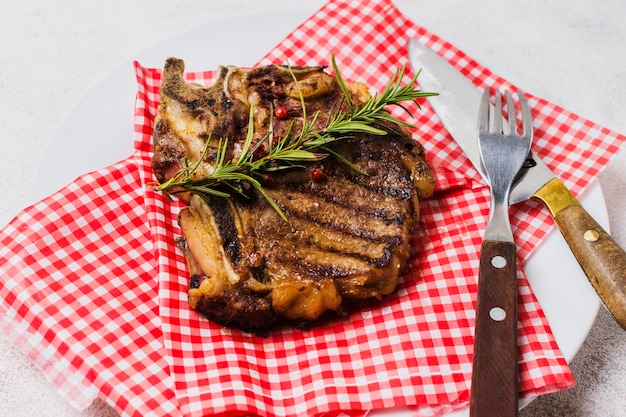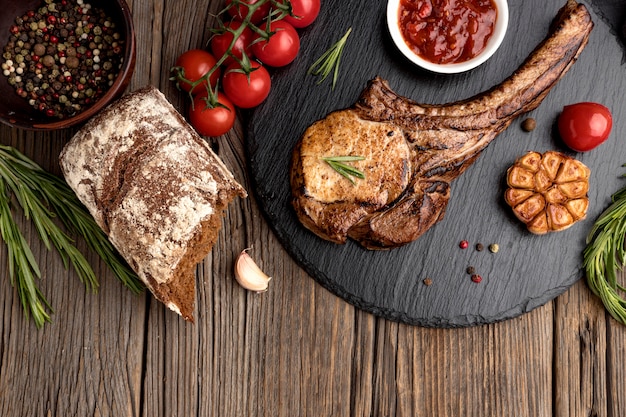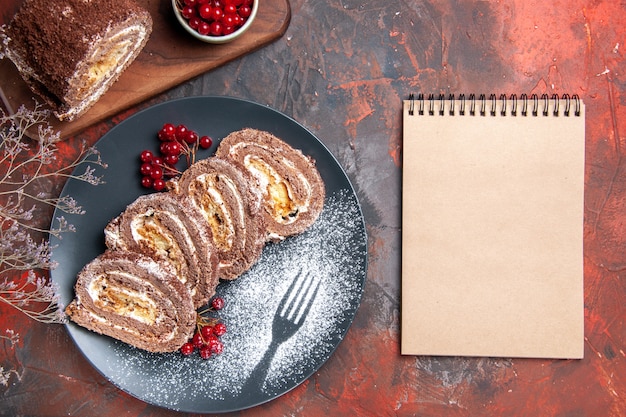Let's talk about prime rib, a dish that's always a crowd-pleaser. I've been cooking for years, and there's nothing quite like a perfectly cooked prime rib. The aroma alone is enough to make your mouth water, and the taste? It's simply divine. But let's be honest, tackling a 9-pound prime rib can seem a bit intimidating, especially if you're a kitchen newbie. You've got all these questions swirling in your head: how long to cook it, how to ensure that perfect rosy hue, and how to guarantee it's juicy and tender.
Fear not, my culinary comrades! I'm here to guide you through the world of prime rib cooking. I'm going to break down the whole process, step by step, with some handy tips and tricks I've learned over the years. It's all about understanding the basics and then tweaking things to suit your taste. Once you've got the hang of it, you'll be whipping up prime rib like a seasoned pro.
(Part 1) The Prime Rib Basics

Let's start with the essentials, the foundation of a stellar roast. It's all about getting to know your prime rib, like you're forging a new friendship.
Choosing the Right Prime Rib: A Matter of Preference
First, you need to choose the right prime rib. You'll find it at your local butcher or supermarket. Here's what to consider:
- Bone-in or Boneless: It's a personal preference. I favour bone-in because it adds extra flavour and helps with even cooking. But if you prefer something easier to carve, boneless might be your go-to.
- Ribs: Prime ribs usually have 3-7 ribs. For a large crowd, go for the 7-rib option, but for a smaller gathering, a 3-rib roast will do nicely.
- Marbling: Look for those white streaks of fat throughout the meat. The more marbling, the juicier and tastier your prime rib will be. Aim for a good amount of marbling, but not too much, or you'll end up with a fatty roast.
Getting the Prime Rib Ready: Setting the Stage for Success
Now that you've got your prime rib, it's time to get it prepped for cooking.
- Pat It Dry: Once you bring your prime rib home, give it a good pat down with paper towels to ensure it's completely dry. This helps with browning and prevents steam from forming, which can hinder a crispy crust.
- Salt and Pepper: Season it generously with salt and pepper. This is a crucial step as it draws out moisture and adds flavour during cooking.
- Bring It to Room Temperature: Allow your prime rib to rest at room temperature for at least 30 minutes before cooking. This helps ensure even cooking by allowing the meat to warm up to a more consistent temperature.
(Part 2) The Art of Roasting: Mastering the Heat

Okay, we're getting to the heart of it – the actual roasting. It's all about precision, but don't worry, I'm going to guide you every step of the way.
Understanding Your Oven: The Key to Consistency
Before you even think about preheating, you need to understand how your oven operates. Ovens have different temperature variations, and you need to adjust cooking time based on your specific oven.
- Oven Temperature: For a perfect prime rib, the ideal temperature is around 450°F (232°C). This high heat is essential for searing the outside and creating a beautiful crust. Some prefer a lower temperature, but I've found that the high heat method yields the most desirable results.
- Preheating: Always preheat your oven to the correct temperature before placing the prime rib inside. This ensures that the meat cooks evenly and doesn't get stuck in a temperature limbo.
roasting time and Temperature: A Recipe for Success
A 9-pound prime rib typically takes around 2.5-3 hours to cook. But remember, it's all about the internal temperature, not just the clock. Here's the breakdown:
- High Heat Start: Begin with the high heat at 450°F (232°C) for the first 15-20 minutes. This searing step creates a delicious crust and locks in flavour.
- Lower Heat: After the initial searing, lower the oven temperature to 325°F (163°C) and continue cooking until the internal temperature reaches your desired level. The lower temperature allows the meat to cook evenly and prevents overcooking.
Checking the Internal Temperature: Ensuring Perfect Doneness
This is the crucial part. You need to check the internal temperature of your prime rib to guarantee it's cooked to perfection.
- Use a meat thermometer: A meat thermometer is your best friend for prime rib. It eliminates guesswork. Insert the thermometer into the thickest part of the roast to get an accurate reading.
- Internal Temperature Chart: Use this chart as your guide:
Doneness Internal Temperature Rare 125-130°F (52-54°C) Medium-Rare 130-135°F (54-57°C) Medium 135-140°F (57-60°C) Medium-Well 140-145°F (60-63°C) Well-Done 145°F (63°C) and above - Resting Time: Once the prime rib has reached your desired temperature, remove it from the oven and let it rest for at least 15 minutes before carving. This allows the juices to redistribute throughout the meat, preventing it from becoming dry.
(Part 3) The Secret Ingredient: Flavor

Now, we're going to talk about how to really make your prime rib shine. It's all about adding a touch of magic with flavour, and I've got some tricks up my sleeve.
Seasoning: More Than Just Salt and Pepper
While salt and pepper are essential, why stop there? Get creative and experiment with other seasonings to create a truly unique flavour profile.
- Garlic: I love using garlic powder or fresh garlic cloves for that extra punch of flavour. A little garlic goes a long way!
- Herbs: Rosemary, thyme, and oregano are classic choices that complement the rich flavour of prime rib. You can even add some fresh herbs to the roast before it goes in the oven.
- Paprika: For a bit of smoky flavour, try adding some paprika. It adds a subtle warmth that elevates the taste.
- Onion Powder: This adds a savory depth to your roast, enhancing its overall richness.
Flavor Boosters: Elevate Your Roast Beyond the Ordinary
You're not limited to just seasoning the prime rib itself. You can add additional flavour throughout the cooking process.
- roast vegetables: Add some vegetables like carrots, potatoes, and onions to your roasting pan. They'll absorb the delicious juices from the prime rib while adding a delightful side dish to your meal.
- Wine or Beer: Adding a cup of red wine or beer to the roasting pan adds moisture and enhances the flavour of the roast. The liquid helps to create a beautiful crust and adds a hint of depth. You can deglaze the pan with the wine or beer after the roast is done to make a delicious sauce.
- Pan Sauce: After roasting, you can create a decadent pan sauce by deglazing the roasting pan with wine, broth, or even water. Scrape up those browned bits from the bottom of the pan for a truly flavourful sauce.
(Part 4) The Ultimate Prime rib recipe: A Step-by-Step Guide
Alright, let's put all this together in a recipe you can follow, so you're ready to impress your friends and family.
Ingredients:
- 9-pound bone-in prime rib roast, at room temperature
- 1 tablespoon salt
- 1 tablespoon black pepper
- 1 teaspoon garlic powder
- 1 teaspoon onion powder
- 1 teaspoon paprika
- 1 teaspoon dried rosemary
- 1 teaspoon dried thyme
- 1 cup red wine (optional)
- 1 cup beef broth (optional)
- 1 tablespoon olive oil (for basting)
Instructions:
- Preheat oven to 450°F (232°C).
- Season the prime rib roast generously with salt, pepper, garlic powder, onion powder, paprika, rosemary, and thyme. Rub the seasonings into the meat to ensure they adhere well.
- Place the prime rib roast in a roasting pan and add the red wine and beef broth, if using. The liquid will help to create a moist and flavorful roast.
- Roast the prime rib for 15-20 minutes at 450°F (232°C), or until a nice crust forms on the outside. This searing step is essential for creating a beautiful crust and locking in the flavour.
- Reduce the oven temperature to 325°F (163°C) and continue cooking until the internal temperature of the roast reaches your desired level of doneness. Use a meat thermometer to check the temperature in the thickest part of the roast.
- Remove the prime rib from the oven and let it rest for 15 minutes before carving. This allows the juices to redistribute throughout the meat, preventing it from becoming dry.
- While the roast is resting, make a pan sauce by deglazing the roasting pan with wine, broth, or water. Scrape up the browned bits from the bottom of the pan for extra flavour. The sauce will be rich and delicious.
- Serve the prime rib with your favourite sides and enjoy!
(Part 5) Tips from a Prime Rib Pro: Insights from the Kitchen
Over the years, I've picked up a few tricks of the trade. Here's my personal advice for a perfect prime rib experience.
Don't Overcook It! A Recipe for Tenderness
Remember, prime rib is best cooked to medium-rare or medium. Overcooking will result in a tough and dry roast. It's best to err on the side of undercooked, as you can always cook it a bit longer if needed.
Basting for Extra Moisture: Keeping It Juicy
Basting your prime rib with butter, oil, or broth during cooking helps keep it moist and flavorful. I usually baste it every 30 minutes, but you can adjust the frequency based on your preferences.
The Right Cut for the Job: Choosing the Perfect Prime Rib
A rib roast, also known as a standing rib roast, is the most popular choice for prime rib. You'll find it at your local butcher shop, or even some supermarkets. Look for a roast with good marbling for maximum flavour and juiciness.
Get to Know Your Oven: Consistency Is Key
Different ovens have different temperature variations, so it's important to understand your specific oven. I suggest using an oven thermometer to make sure your oven is set to the correct temperature. This will help you achieve consistent results every time.
Patience Is Key: Slow and Steady Wins the Race
cooking prime rib takes time, so don't rush it. Let it cook slowly and evenly to ensure a tender and juicy result. Resist the temptation to peek too often, as opening the oven door can cause the temperature to drop, affecting the cooking time.
(Part 6) Beyond the Basics: Creative Options
Now that you've got the foundation down, let's get a little adventurous. Prime rib doesn't have to be just one way.
Flavor Variations: Experiment with Flavour
Experiment with different herbs and spices to create your own unique flavour combinations. Try adding a pinch of chili powder or cayenne pepper for a bit of heat, or try a combination of Dijon mustard and brown sugar for a sweet and savory glaze. Let your imagination run wild!
Unique Cooking Methods: Expand Your Repertoire
You can even cook your prime rib using different methods, expanding your culinary repertoire.
- slow cooker: For a tender and flavorful prime rib, you can try cooking it in a slow cooker on low heat for 8-10 hours. The slow and gentle cooking method results in incredibly tender meat.
- reverse searing: Cook the roast at a lower temperature for a longer time, then sear it at a high heat for a crispy crust. This method helps create a juicy and tender roast with a nice sear. It's a great technique for those who prefer a more evenly cooked roast.
Creative Sides: The Perfect Accompaniments
Elevate your meal with creative sides that pair perfectly with prime rib. Try a medley of roasted root vegetables, a creamy mashed potato gratin, or a simple salad with a tangy vinaigrette. You can also try adding a side of roasted asparagus or Brussels sprouts for a bit of bitterness to balance out the richness of the prime rib.
(Part 7) Carving Like a Pro: Mastering the Art of Presentation
Alright, the moment of truth: carving your prime rib. It's all about technique, and I'm here to share my secrets.
Sharp Knife Is Essential: The Foundation of a Clean Cut
First things first: a sharp knife! It's not the time for a dull blade, trust me. You'll need a good, sturdy carving knife, preferably with a long, thin blade.
Carving a Bone-in Prime Rib: A Step-by-Step Guide
Here's how to carve a bone-in prime rib like a pro.
- Start with the bone: If you’ve got a bone-in roast, start by carving down along the side of the bone to remove the first slice of meat. This will make it easier to carve the remaining slices.
- Cut perpendicular to the bone: Once you've removed the first slice, cut perpendicular to the bone to slice the rest of the roast. This ensures that you get even slices of meat.
- Cut against the grain: The key to a tender and delicious prime rib is to cut against the grain. The grain runs the length of the muscle fibres, so you want to cut across them to prevent the meat from being tough and stringy.
Carving a boneless prime rib: Effortless Carving
A boneless roast is easier to carve. You can simply cut the roast into thin slices, perpendicular to the grain. This method ensures that you get even and beautiful slices of meat.
Presentation Matters: A Feast for the Eyes
Don't underestimate the power of a good presentation! Arrange your slices of prime rib on a platter, and don't forget to add some of those roasted vegetables or a dollop of creamy sauce. This will make your prime rib look even more enticing.
(Part 8) Leftovers: Don't Throw Them Away!
You've got a delicious prime rib, you've carved it beautifully, and now you're left with some leftovers. Don't worry, leftovers can be just as delicious as the original roast.
Prime Rib Sandwiches: A Classic Leftover Treat
My go-to for prime rib leftovers? Sandwiches! Pile your prime rib on a crusty roll with some cheese, onions, and your favourite sauce. It's a fantastic lunch or dinner option.
Prime Rib Soup: A Hearty and Comforting Option
You can also make a delicious and hearty soup with prime rib leftovers. Just simmer the leftover meat in broth with vegetables and spices. This is a great way to use up leftovers and create a warm and satisfying meal.
Prime Rib Hash: A Savory and Versatile Dish
Another great way to use up prime rib leftovers is to make hash. Simply chop the leftover meat and fry it with onions, potatoes, and your favourite seasonings. This is a versatile dish that can be served for breakfast, lunch, or dinner.
Prime Rib Pizza: A Gourmet Twist on a Classic Favourite
Get adventurous with a prime rib pizza! Top your pizza dough with a layer of sauce, cheese, and sliced prime rib. It's a gourmet twist on a classic favourite.
FAQs
Q: What if my prime rib is too salty?
Don't worry, there are ways to reduce the saltiness. You can try soaking the meat in cold water for a few hours, or you can rinse it under cold water before cooking. If you're worried about overdoing it, start with less salt and adjust as needed. A little bit of trial and error goes a long way.
Q: What if my prime rib is too dry?
A dry prime rib is a common problem. It's often caused by overcooking. To prevent dryness, cook it to the correct internal temperature and let it rest for at least 15 minutes before carving. You can also try basting it regularly during cooking. Basting helps to keep the meat moist and flavorful.
Q: Can I cook prime rib in a slow cooker?
Yes, you can definitely cook prime rib in a slow cooker. It's a great way to ensure a tender and flavorful roast. Just make sure to cook it on low heat for 8-10 hours. slow cooking allows the meat to break down and become incredibly tender.
Q: What's the best way to reheat prime rib?
The best way to reheat prime rib is to use a low oven. Preheat your oven to 250°F (121°C) and reheat the prime rib for about 30 minutes, or until it's heated through. This method ensures that the meat is reheated evenly without drying it out.
Q: How long can I store prime rib leftovers in the refrigerator?
You can safely store prime rib leftovers in the refrigerator for 3-4 days. Make sure to wrap it tightly in plastic wrap or aluminum foil to prevent freezer burn. This will help keep the meat fresh and flavorful.
Everyone is watching

How to Cook Frozen Lobster Tails Perfectly: A Step-by-Step Guide
RecipesLobster. Just the word conjures up images of lavish meals, special occasions, and a taste of luxury. But let's...

Pigs in a Blanket Cooking Time: How Long to Bake for Perfect Results
RecipesAh, pigs in a blanket. Just the name conjures up images of those delightful little parcels of crispy pastry en...

Pork Fillet Cooking Time: How Long to Cook It Perfectly
RecipesPork fillet, or tenderloin as it's sometimes called, is a real favourite in our house. It's so versatile, and...

The Ultimate Guide to Tender, Juicy Pulled Pork
RecipesRight, let's talk pulled pork. It's one of those dishes that just screams "comfort food," doesn't it? I mean...

The Ultimate Guide to Cooking Sweet Potatoes: From Roasting to Mashing
RecipesSweet potatoes. Just the name conjures up images of warm, comforting dishes, bursts of vibrant color, and a to...
